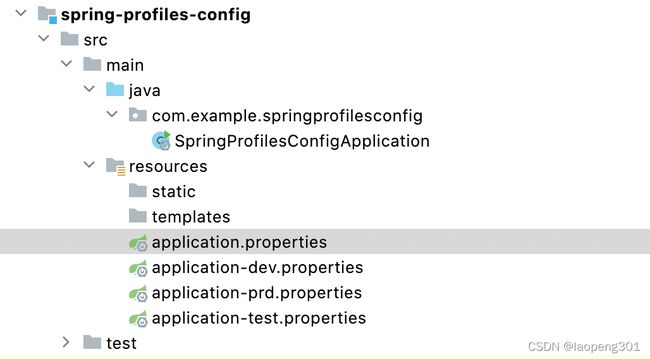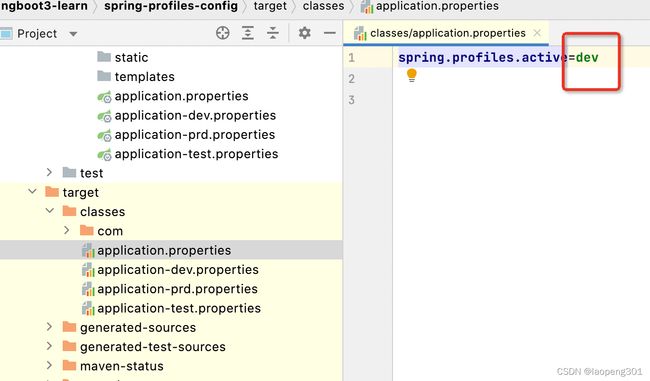Spring Boot 3.x特性-Profiles&多环境配置
系列文章目录
系列文章:Spring Boot 3.x 系列教程
文章目录
- 系列文章目录
- 前言
- 一、Profiles激活
-
- 1.注解激活
- 2.配置属性激活
- 3.添加多个激活的Profiles
- 4.Profiles组
- 二、多环境配置
- 三、maven多环境打包
- 总结
前言
Spring Profiles 提供一种方法来隔离应用程序配置的各个部分,并使其仅在某些环境中可用。
并且和application属性文件一样,Spring Boot也会尝试使用命名约定application-{profile}来加载特定配置文件的文件。
例如,如果你的应用程序激活一个名为prod的配置文件并使用YAML文件,那么application.yml和application-prod.yml文件将会被加载。
一、Profiles激活
1.注解激活
任何@Component, @Configuration或@ConfigurationProperties都可以用@Profile标记来限制加载。
@Configuration(proxyBeanMethods = false)
@Profile("production")
public class ProductionConfiguration {
// ...
}
如果@ConfigurationProperties bean是通过@ Enableconconfigurationproperties而不是自动扫描注册的,则需要在具有@Enableconconfigurationproperties注解的@Configuration类上指定@Profile注释。在扫描@ConfigurationProperties的情况下,@Profile可以在@ConfigurationProperties类本身上指定。
2.配置属性激活
除了注解激活配置属性,你可以在application.properties中使用spring.profiles.active配置环境属性激活profiles,
spring:
profiles:
active: "dev,hsqldb"
你也可以在命令行中指定它,使用下面的开关:--spring.profiles.active=dev,hsqldb
spring.profiles.active和spring.profiles.default只能在non-profile 文档中使用。这意味着它们不能包含在spring.config.activate.on-profile激活的配置文件或profile文件中使用。
例如:可以在application.properties中使用spring.profiles.active属性,但是在application-dev.properties中不可以使用,启动时程序会报如下错误:
Property 'spring.profiles.active' imported from location 'class path resource [application-dev.properties]' is invalid in a profile specific resource [origin: class path resource [application-dev.properties]
考虑如下on-profile文件:
# 这个文档有效
spring:
profiles:
active: "prod"
---
# 无效
spring:
config:
activate:
on-profile: "prod"
profiles:
active: "metrics"
3.添加多个激活的Profiles
spring.profiles.active属性规则与其他属性相同的排序规则:最高优先级的PropertySource生效。
这意味着可以在application.properties中激活profile,然后使用命令行开关替换它。
有时,让属性添加到激活profile而不是替换它们是很有用的。
spring.profiles.include属性可用于在spring.profiles.active属性激活的配置文件之上添加激活的配置文件。SpringApplication入口点也有一个Java API,用于设置额外的配置文件。参见SpringApplication中的setAdditionalProfiles()方法。
例如,当运行具有以下属性的应用程序时,common和local profiles文件都会被激活,
当它使用——spring.profiles.active开关:
spring:
profiles:
include:
- "common"
- "local"
与
spring.profiles.active一样spring.profiles.include只能在non-profile文档中使用。这意味着它们不能包含在spring.config.activate.on-profile激活的配置文件或profile文件中使用。
4.Profiles组
有时候,在应用程序中定义和使用的profiles粒度太细,使用起来很麻烦。例如,您可能使用proddb和prodmq profiles 文件来独立启用数据库和消息传递特性。
为了帮助实现这一点,Spring Boot允许定义profile组。配置文件组允许为相关的配置文件组定义一个逻辑名称。
例如,我们可以创建一个由proddb和prodmq profile组成的production组。
spring:
profiles:
group:
production:
- "proddb"
- "prodmq"
我们的应用程序现在可以使用——spring.profiles.active =production一次激活production、proddb和prodmq配置文件。
二、多环境配置
通常正常开发过程中会存在多套环境,常见的开发环境(dev)、测试环境(test)、生产环境(prod),这种情况下我们可以新建多个application.properties(或yml):

spring.profiles.active 属性可以指定当前设置的环境,以此来选择适合的配置文件,例如当spring.profiles.active=prd时,系统将加载application.properties 和application-prod.properties配置文件。
上述方法多环境配置文件力度比较粗,假如每个环境存在多个配置文件 redis,mysql,mq单独拆开。针对这种情况可以使用Profile Group:
然后每个配置文件添加一个变量用于测试:


测试代码:
@SpringBootApplication
public class SpringProfilesConfigApplication {
@Value("${spring.profiles.active}")
private String env;
@Value("${pf.mq}")
private String mq;
@Value("${pf.redis}")
private String redis;
@Value("${pf.mysql}")
private String mysql;
public static void main(String[] args) {
SpringApplication.run(SpringProfilesConfigApplication.class, args);
}
@Component
public class MyApplicationRunner implements ApplicationRunner {
@Override
public void run(ApplicationArguments args) throws Exception {
System.out.printf("当前激活的配置环境是{%s}:mq:%s,mysql:%s,redis:%s", env, mq, mysql, redis);
}
}
}
当激活prd环境时:
三、maven多环境打包
spring.profiles.active 属性的设置简单的方式application.properties指定,但是存在一个问题,单程序打包时不能每次去更改配置这样非常麻烦,那么可以把这个属性值设置成变量,maven编译打包时动态传入。比如在application.properties文件中配置如下:
[email protected]@
1.在pom.xml中添加如下内容,多个环境添加多个profile节点即可,但是需要指定一个默认的环境:
<profiles>
<profile>
<id>devid>
<properties>
<!-- 环境标识,与配置文件的名称相对应,标签变量要与profile.active保持一致 ->
<profile.active>devprofile.active>
properties>
<activation>
<activeByDefault>trueactiveByDefault>
activation>
profile>
<profile>
<id>testid>
<properties>
<profile.active>testprofile.active>
properties>
profile>
<profile>
<id>prodid>
<properties>
<profile.active>prodprofile.active>
properties>
profile>
profiles>
接下来添加maven打包插件
<build>
<resources>
<resource>
<directory>src/main/resourcesdirectory>
<filtering>truefiltering>
resource>
resources>
<plugins>
<plugin>
<groupId>org.springframework.bootgroupId>
<artifactId>spring-boot-maven-pluginartifactId>
<configuration>
<mainClass>com.example.springprofilesconfig.SpringProfilesConfigApplicationmainClass>
configuration>
<executions>
<execution>
<goals>
<goal>repackagegoal>
goals>
execution>
executions>
plugin>
plugins>
build>
添加上面插件后IDEA可以选择对应profile环境
执行 compile,查看编译打包后的配置文件如下:

@profile.active@变量已被替换成对应的proflie环境值。
总结
本文主要是基于Profiles特性来支持多环境配置属性的实现,以及maven多环境打包,其实大多数生产环境配置类文件,一般都使用分布式配置相关的中间件,比如Nacos,Apollo等等。

